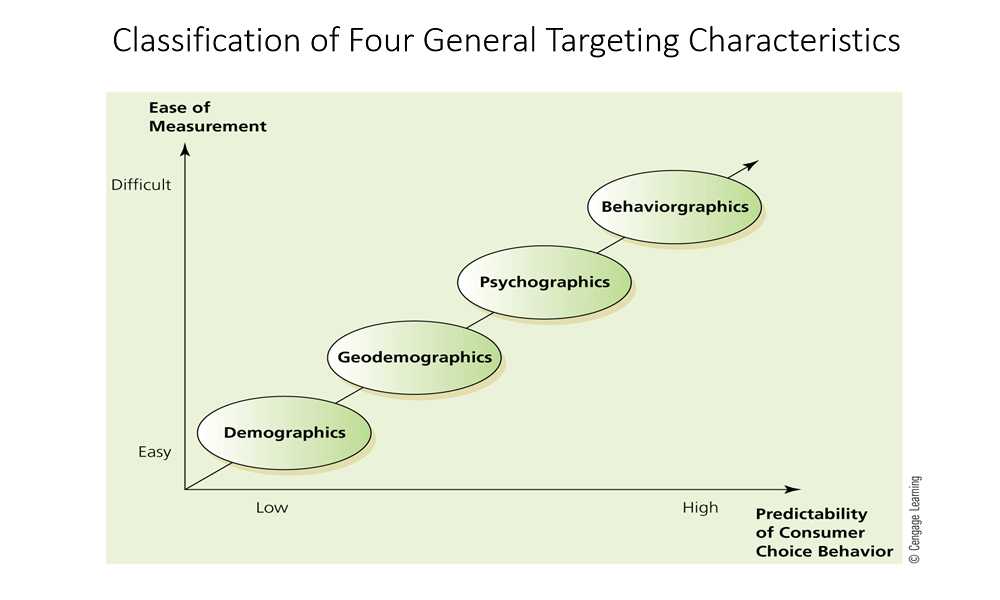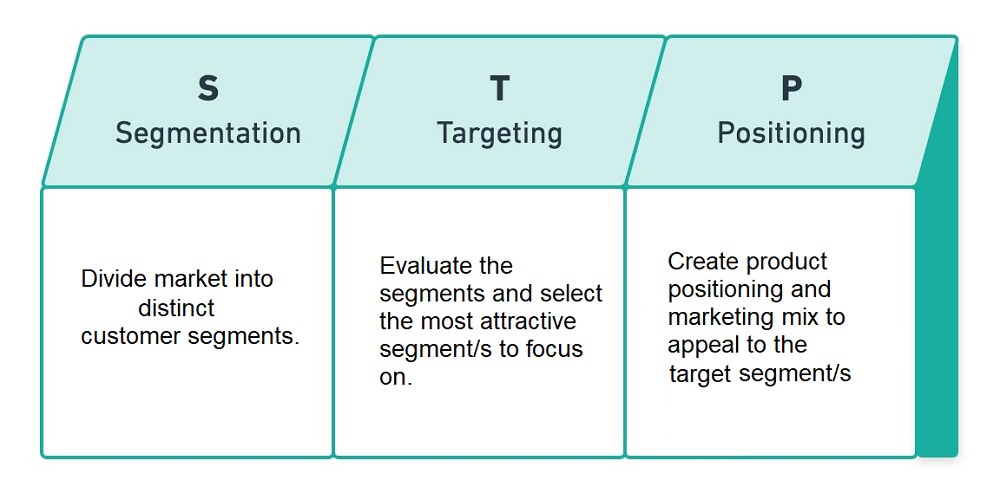
Target marketing involves selecting the appropriate target market/s from the entire market and effectively marketing to them. It is a common practice in marketing to divide the market into various smaller homogeneous segments and then target the more lucrative ones which are likely to be receptive to the products in order to generate more sales.
Related: Segmentation, Targeting, Positioning (STP) in Marketing
Targeting Process
A target market is a group of consumers most likely to buy a company’s products or services. So, it makes sense for the company to focus its marketing efforts on this group, as opposed to marketing to everyone, which could be inefficient and expensive.
The three main activities of target marketing are segmenting, targeting and positioning (commonly referred to as the S-T-P marketing process). Marketers use this approach to figure out segments which will offer the best profit potential and how to effectively market to them.
Once market segmentation is carried out, the next step is to identify the appropriate market/s to target, and then figure out how positioning of the products/services will be done to this target market.
Market Targeting Process typically involves two steps:
- First step is to evaluate market segmentation and select segments that are more likely to suit the business.
- Second step involves selecting the appropriate market targeting strategies.
Criteria for an Effective Segment
Once the various segments are listed, the business may identify a new segment to be targeted. The various criteria for an effective segment inlcude.
- Measurable: Size, purchasing power and characteristics of segment can be measured
- Substantial: Segment is large and profitable enough to serve
- Accessible: Segment can be effectively reached and served
- Differentiable: Segments are conceptually distinguishable and respond differently to different marketing mix elements
- Actionable: Effective programs
Evaluation of Market Segments – DAMP
Kotler’s (1984) DAMP model is commonly used to target the right segments.
- Distinct – is each segment clearly different from other segments?
- Accessible – can buyers be reached through appropriate promotional programmes and distribution channels?
- Measurable – is the segment easy to identify and measure?
- Profitable – is the segment sufficiently large to provide a stream of constant future revenues and profits?
So marketers need to define the segment to target and discuss the needs and wants of this segment. They need to provide the reasons why this segment is targeted with the help of Kotler’s DAMP model. Theyneed to justify why this target segment is Distinct, Accessible, Measurable and Profitable (DAMP).
Rating Different Segments
Rating approach for different segment attractiveness factors:
- Market growth
- Segment profitability
- Segment size
- Competitive intensity within the segment
- Cyclical nature of the industry
Each of these attractiveness factors is rated on a scale of 0-10 and loosely categorized as high, medium or low in attractiveness.
Types of Target Marketing Strategies
Undifferentiated marketing
In undifferentiated marketing, a company may use a single marketing mix for the whole market. So basically, there is absence of segmentation.
This could also be because there are no strong differences in customer characteristics. Alternatively, the cost of developing a separate marketing mix for separate segments may not be worth it.
Under these circumstances a company will use a single marketing mix.
Companies that lack customer knowledge may adopt this strategy by default.
Big companies with a huge budget may also adopt this strategy at times. Ford’s Model T is a classical example of undifferentiated targeting strategy. Customers had to buy the product as there was no alternate offering. Companies that follow undifferentiated targeting strategies may also save on production and marketing costs as only one product is to be marketed.
However, the drawback of undifferentiated targeting strategy is that it doesn’t take into account the preferences of different customers and assumes that they all will like the product.
Differentiated (or Multi-segment Targeting) Marketing
With differentiated marketing, you formulate a separate marketing mix for the two or more segments you choose to target. You may not target all segments in a given market, but for those you rank as priorities, you will need different marketing mixes geared to each segment’s unique characteristics and behaviours.
The assumption is that you can provoke a different response from each segment by using different marketing mixes. Customers benefit because their needs are being addressed, which increases satisfaction and loyalty. Moreover, you can compete more effectively by tailoring the marketing mix for each segment, although this is much more costly than undifferentiated marketing and may overburden resources if not carefully managed.
Germany’s ‘BMW’ Group (www.bmwgroup.com), which owns the ‘BMW’ brand, the Mini brand, and the Rolls-Royce brand, uses differentiated marketing to target multiple segments.
Focus or concentrated targeting
Companies have realized that focusing on the needs of a narrowly defined market segment can be profitable than spreading resources over several different segments. Starbucks is one example. It focusses exclusively on customers who wanted gourmet coffee products.
The strategy will appeal more to companies with limited resources, as opposed to large organizations who may not be interested to serve a niche segment.
For niche marketers, the risk is, if they become successful, they will attract competition from the larger players.
Customized marketing
In some markets, it is economically viable to design a marketing mix to target the unique requirements of some customers. In such cases, the value of an order is high which justifies the large marketing and sales efforts focused on each buyer.
Many service providers such as advertising & marketing research firms, architects and solicitors vary their offerings on a customer to customer basis.
Examples
Netflix’s Target Audience
Netflix is a Subscription-based streaming service provide. Here’s how Netflix targets the various segments:
- Most customers of Netflix are in the 18-45 age group, this group comprises the largest group of Netflix viewers.
- The company has wide range of plans, including lower priced plans to target the middle and lower middle class customer segments.
- In the emerging economies, where consumers are price sensitive, the company introduced smaller plan allowing users to access content only on smartphone devices.

BATheories.com is managed by a group of educators from Mumbai. We also manage the website StudyMumbai.com. Our panel includes experienced professionals and lecturers with a background in management. BATheories is where we talk about the various business theories and models for BA (Business Administration) students.